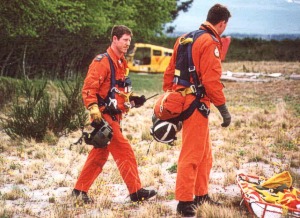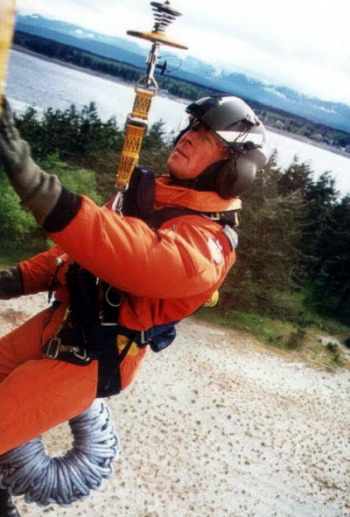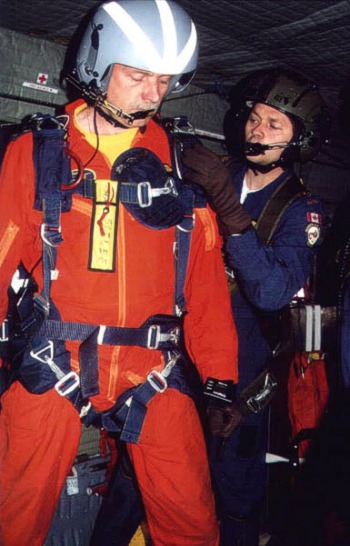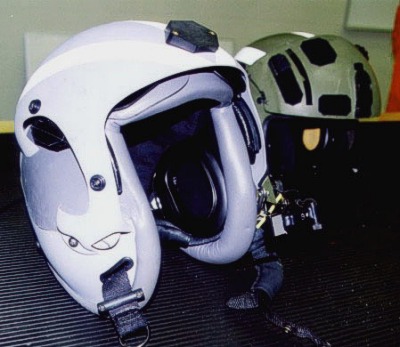In the world of Search and Rescue, getting lost is the easy part. Being
found something totally different.
This article deals with the operations of the Canadian 442 T&R Squadron. This
Transport and Rescue Squadron operates the CH-149 Cormorant (EH-101) and the CC-115
Buffalo (DHC-5). During our flights with 442, it still operated the CH-113 Labrador
(KV-107) wich is now replaced. CFB Comox can be found at Vancouver Island and also houses
a Maritime Patrol unit with the CP-140 Aurora (P-3 Orion). On the airbase premisis an
excellent museum can be found that also includes a lot of historic flight gear (from the
Snowbirds and CF-101 to ejection seats.)

Operations:
The Comox ramp is a mixture of grey and bright yellow as the CT-133's and CP-140's share
it with the 442 Sq. birds. In the background the ever-present mountains and glaciers that
dominate the British Columbia landscape. Suddenly the air is filled with the sound of
helicopter rotors as "Rescue 307" leaves the tarmac. This time another daily
practice mission to train the pilots and SAR Techs. Once airborne, the CH-113A heads for
the Strait of Georgia. This strait is situated between Vancouver Island and the mainland.
The crew is already preparing for the practice hoist when a small tree covered island
comes in sight. The entire crew takes their position and the Labrador is lowered into a
clearing in the woods. This is a risky operation as the big helicopter can strike a tree
or hit loose branches being thrown in to the air by the rotor blades.
Just seconds after touchdown, the mission takes a dramatic turn. A real mayday call is
received by 442 Ops and forwarded to us, being the closest to the scene. The crew shows
their high skill. Once the helicopter is airborne again, SAR Techs rapidly change clothes
and gear as the pilots are heading for the location of the emergency. It turns out to be a
little boat that has been thrown on a rock. The SAR Techs are ready to be lowered in to
the water to give assistance. The big Labrador helicopter comes down to take a look and
circles the emergency site. After a couple of low passes and radio contact it is decided
it is safe to leave things to the Coast Guard. Within minutes a Coast Guard vessel comes
in sight. Stationed at Comox harbour, it can quickly respond to a call for help. The
helicopter makes a final pass and heads towards another training area. Over here the
exchange US Coast Guard pilot takes the helicopter to the ground and the practice hoist
finally begins. This time a small aircraft crash respons is trained. Two pilots, one
flight engineer and two SAR Techs man the Labrador. It is capable of carrying 1500 pounds
of medical and survival equipment and its hoist is able of lifting up to 600 pounds.

For long distance response,
442 Sq. relies on the CC-115 Buffalo transport plane. This high wing aircraft is capable
of STOL (Short Take Off and Landing) on remote airstrips. Working from the Buffalo
requires different skills from the flight crew. Mission “Rescue 456” takes off
from Comox for a flight to Texeda Island. On arrival, the crew throws out streamers to
check the wind direction and take a sharp lookout for dangerous objects . Shortly before
arriving over the dropzone, the pilot hands over the plane to the Flight Engineer. By
giving specific commands, he places the aircraft exactly overhead the right spot. Through
the open cargo ramp, the two SAR Tech’s are jumping out at an altitude of 1000
feet.

As the Buffalo is circling
overhead, the SAR Tech’s are making a decision on what is needed for this operation.
The Flight Engineer on board takes the equipment and drops it using small parachutes. This
is done on a very low pass over the dropzone. After a while the SAR Tech’s are
requesting a pick up and “Rescue 456” decends into Texeda’s small airstrip.
On touchdown, the STOL (Short Take Off and Landing) capabilities are a usefull feature.
Within a couple of seconds we make a complete stop and take on board the Tech’s. In
no time we are on the threshold again and halfway the airstrip the CC-115 is airborne
again.
It also carries a lot of equipment that is too large to be carried aboard the CH-113A. It
is very capable of dropping gear and SAR Techs through its large cargo ramp in the back.
The crew consists, beside two pilots, of a navigator a flight engineer and two SAR Techs.
The flight engineer assists in the aerial drop of survival items and helps the SAR Techs
checking their gear. The navigator also can act as a radio relay during combined
operations.
SAR Techs:
The SAR Techs have the choice a wide selection of items to do their task. Ranging from
life rafts and parachutes to complete medical kits for every thinkable situation. Every
SAR Tech is a trained EMT (Emergency Medical Technician) and is skilled in scuba diving,
mountain climbing, precision parachuting and, most important, survival. Every SAR Tech is
a volunteer, prepared to take a calculated risk that may be necessary to do his task. The
Comox SAR Tech team consists of 21men and one woman. After a one year training at the SAR
Tech school (also at Comox) the fresh SAR Tech is added to an operational unit and needs
another year of training before becoming an operational member of a team.
For medical emergencies the SAR Tech uses a combination of items, all packed in separate
kits. One of them is the supplementary kit. This kit has a wide range of medical equipment
for different injuries. Among them a kit for burning wounds, eye injuries and delivering
children. Also available the new casualty blanket. For easy access to the victim, the
waterproof blanket has holes close to every body part.
When scuba diving, the Tech uses a full-face diver mask with communications. For other sea
operations the crew can drop life rafts for up to 10 persons. A new motorised one is
currently under development and should be able to find its way unmanned to the victims.
The new raft is fitted with GPS and camera's and should be able to sail for 250 miles
remote controlled or using GPS. The Buffalo's drops these rafts and can also drop large
pumps when a boat is taking in water.

The SAR Techs are
equipped with two types of flight helmets, being the SPH-5CF and the Gentex DH 190.
Mustang life preservers and different types of clothing complete the outfit.
Besides the orange coverall a brush suit is worn. The thick brush suit prevents the wearer
from sharp objects encountered when being lowered in to the woods. The SAR Techs are on a
constant standby status. The response time for the crew to board the aircraft and be under
way is half an hour. 24 hours a day, 365 days a year.
We like to thank Col. GY Smith, WO William C Ford, LT.
(N) JG. Coppard and the dedicated 442 crewmembers for their help. |